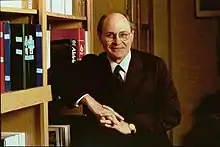Daniel Nathans | |
|---|---|
 | |
| Born | October 30, 1928 |
| Died | November 16, 1999 (aged 71) |
| Nationality | American |
| Education | University of Delaware (BS) Washington University in St. Louis (MD) |
| Known for | Restriction enzymes |
| Spouse | Joanne Gomberg |
| Awards | NAS Award in Molecular Biology (1976) Nobel Prize in Physiology or Medicine (1978) National Medal of Science (1993) |
| Scientific career | |
| Fields | Microbiology |
| Institutions | Johns Hopkins School of Medicine Columbia Presbyterian Medical Center |
| Doctoral students | Robert F. Margolskee Marilyn S. Kozak |
Daniel Nathans (October 30, 1928 – November 16, 1999) was an American microbiologist. He shared the 1978 Nobel Prize in Physiology or Medicine for the discovery of restriction enzymes and their application in restriction mapping.[1]
Early life and education
Nathans was born in Wilmington, Delaware, the last of nine children born to Russian Jewish immigrant parents, Sarah (Levitan) and Samuel Nathans. During the Great Depression his father lost his small business and was unemployed for a long time.[2]
Nathans attended public schools and then to the University of Delaware, where he received his BS degree in chemistry in 1950. He received his MD degree from Washington University in St. Louis in 1954 and did a one-year internship at Presbyterian Medical Center with Robert Loeb.[2]
Wanting a break before his medical residency, Nathans became a clinical associate at the National Cancer Institute at the National Institutes of Health in Bethesda, Maryland. There he split his time between caring for patients receiving experimental cancer chemotherapy and research on recently discovered plasma-cell tumors in mice, similar to human multiple myeloma. Struck by how little was known about cancer biology, he became interested in protein synthesis in myeloma tumors, and published his first papers on this research.[2]
Nathans returned to Columbia Presbyterian Medical Center for a two-year residency in 1957, again on Robert Loeb's service. He continued working on the problem of protein synthesis as time allowed. In 1959, he decided to work on the research full time and became a research associate at Fritz Lipmann's lab at the Rockefeller Institute in New York.[2]
Career
In 1962, Nathans came to Johns Hopkins School of Medicine as an assistant professor of microbiology. He was promoted to associate professor in 1965 and to professor in 1967. He became the director of the microbiology department in 1972 and served in that position until 1982. In 1981, the department of microbiology was renamed the department of molecular biology and genetics.
In 1982 Johns Hopkins University made Nathans a University Professor, a position in which he served until his death in 1999. He also became a senior investigator of the Howard Hughes Medical Institute unit at Johns Hopkins School of Medicine in 1982.[3]
From 1995 to 1996, Nathans served as the interim president of Johns Hopkins University.
In January 1999, Johns Hopkins School of Medicine established the McKusick-Nathans Institute of Genetic Medicine, a multidisciplinary clinical and research center named for Nathans and pioneering medical geneticist Victor McKusick.[4]
Nathans was also given six honorary doctorates over the span of his career.
Awards
- 1967: Selman Waksman Award in Microbiology
- 1976: NAS Award in Molecular Biology
- 1977: Elected to the American Academy of Arts and Sciences[5]
- 1978: Nobel Prize in Physiology or Medicine
- 1979: Elected to the National Academy of Sciences[6]
- 1985: Elected to the American Philosophical Society[7]
- 1993: National Medal of Science
See also
References
- ↑ Daniel Nathans on Nobelprize.org , accessed 11 October 2020
- 1 2 3 4 "Biographical Overview". Daniel Nathans - Profiles in Science. 2019-03-12. Retrieved 2023-03-26.
- ↑ "The Nobel Prize in Physiology or Medicine 1978". NobelPrize.org. Retrieved 2023-03-26.
- ↑ "The Daniel Nathans Papers: Biographical Information". profiles.nlm.nih.gov. Retrieved 4 April 2018.
- ↑ "Daniel Nathans". American Academy of Arts & Sciences. Retrieved 2022-05-16.
- ↑ "Daniel Nathans". www.nasonline.org. Retrieved 2022-05-16.
- ↑ "APS Member History". search.amphilsoc.org. Retrieved 2022-05-16.
Further reading
- Brownlee, Christen; Nathans, D (April 2005). "Danna and Nathans: Restriction enzymes and the boon to modern molecular biology". Proc. Natl. Acad. Sci. U.S.A. 102 (17): 5909. Bibcode:2005PNAS..102.5909B. doi:10.1073/pnas.0502760102. PMC 1087965. PMID 15840710.
- Dimaio, D (2001). "Daniel Nathans: October 30, 1928-November 16, 1999". Biographical Memoirs of the National Academy of Sciences. 79: 262–79. PMID 11762397.
- Raju, T N (October 1999). "The Nobel chronicles. 1978: Werner Arber (b 1929); Hamilton O Smith (b 1931); Daniel Nathans (b 1928)". Lancet. 354 (9189): 1567. doi:10.1016/S0140-6736(05)76606-X. PMID 10551539. S2CID 53257399.
- Shampo, M A; Kyle R A (April 1996). "Daniel Nathans--geneticist and microbiologist wins Nobel prize". Mayo Clin. Proc. 71 (4): 360. doi:10.4065/71.4.360. PMID 8637258.
- Kroon, A M (February 1979). "The Nobel Prize for Medicine and Physiology in 1978 (Werner Arber, Daniel Nathans, Hamilton Smith)". Nederlands Tijdschrift voor Geneeskunde. 123 (5): 153–6. PMID 368662.
- Piekarowicz, A (1979). "[Werner Arber, Daniel Nathans and Hamilton Smith. Nobel prizes for the studies on DNA restriction enzymes]". Postepy Biochem. 25 (2): 251–3. PMID 388391.
- Desiderio, S; Boyer S (November 1978). "Arber, Smith and Nathans: Nobel Laureates in medicine and physiology, 1978". The Johns Hopkins Medical Journal. 143 (5): ix–x. PMID 364154.
External links
- Daniel Nathans on Nobelprize.org
- The Daniel Nathans Papers - Profiles in Science, National Library of Medicine
- Daniel Nathans — Biographical Memoirs of the National Academy of Sciences